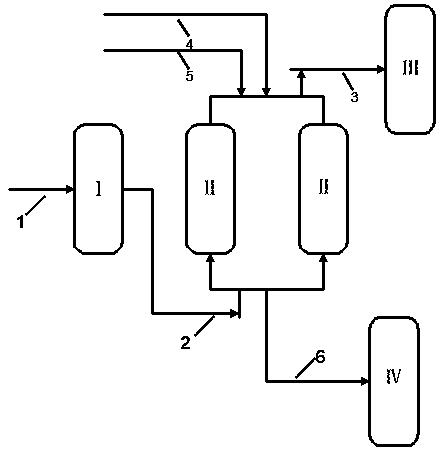Purification method of coking wastewater
A technology for coking wastewater and wastewater, which is applied in chemical instruments and methods, separation methods, water pollutants, etc., can solve the problems of not mentioning the effect of ammonia removal and ammonia removal by activated carbon, high equipment requirements, ozone leakage, etc., and achieve regeneration. Simple and reliable operation, low equipment investment and short process
- Summary
- Abstract
- Description
- Claims
- Application Information
AI Technical Summary
Problems solved by technology
Method used
Image
Examples
Embodiment 1
[0037] The specific implementation is as figure 1As shown in the device process, the coking waste water with a tar concentration of 180mg / L, a volatile ammonia content of 3g / L (ammonium bicarbonate, free ammonia), and a COD (chemical oxygen demand) of 8000 mg / L is sent to the dust removal equipment. Ash pretreatment adsorbent adsorption tower, the coking wastewater after adsorption enters the deammonization adsorption tower, and the attached agent is molecular sieve adsorbent, and the adsorbent adopts hydrophobic ZSM-5 molecular sieve; the adsorbed wastewater is sent to the storage Pool; the tar content in the treated wastewater is 2.2 mg / L, the ammonia nitrogen content is 80 mg / L, and the COD content is 2000 mg / L.
[0038] After the pretreatment adsorbent is adsorbed and saturated, the dedusted dust is filtered and sent to the coal blending station for coal blending. After the adsorbent in the deamination adsorption tower is saturated, it is regenerated with nitrogen at 150°...
Embodiment 2
[0040] The specific implementation is as figure 1 As shown in the device process, the coking wastewater containing tar concentration of 200mg / L is sent to the adsorption tower filled with adsorbent, wherein the adsorbent is a molecular sieve adsorbent, and the adsorbent adopts TS-1 molecular sieve; the coking wastewater after adsorption Send it to the storage tank; part of the wastewater in the storage tank is reused as cooling water, and part of it is discharged. The coking wastewater before treatment contains 200 mg / L of tar, 3 g / L of volatile ammonia, and 8000 mg / L of COD. In the coking wastewater after treatment, the content of tar is 3 mg / L, and the content of ammonia nitrogen is 60 mg / L. The COD content is 1500 mg / L.
Embodiment 3
[0042] The specific implementation is as figure 1 As shown in the device process, the coking wastewater containing tar concentration of 220mg / L is sent to the adsorption tower filled with adsorbent, wherein the adsorbent is molecular sieve adsorbent, and the adsorbent adopts Ti-MOR molecular sieve; the coking wastewater after adsorption is sent to into the storage tank; part of the wastewater in the storage tank is reused as cooling water, and part of it is discharged.
[0043] The coking wastewater before treatment contains a tar concentration of 100 mg / L, a volatile ammonia content of 4 g / L, and a COD of 7000 mg / L. In the coking wastewater after treatment, the tar content is 1 mg / L, and the ammonia nitrogen content is 50 mg / L. The COD content is 1000 mg / L.
PUM
 Login to View More
Login to View More Abstract
Description
Claims
Application Information
 Login to View More
Login to View More - R&D
- Intellectual Property
- Life Sciences
- Materials
- Tech Scout
- Unparalleled Data Quality
- Higher Quality Content
- 60% Fewer Hallucinations
Browse by: Latest US Patents, China's latest patents, Technical Efficacy Thesaurus, Application Domain, Technology Topic, Popular Technical Reports.
© 2025 PatSnap. All rights reserved.Legal|Privacy policy|Modern Slavery Act Transparency Statement|Sitemap|About US| Contact US: help@patsnap.com

